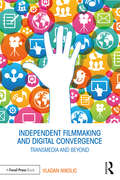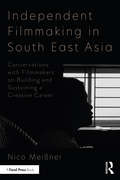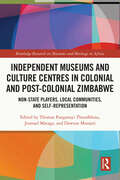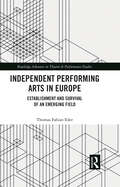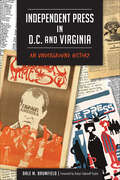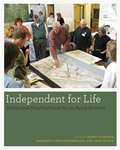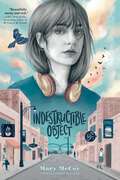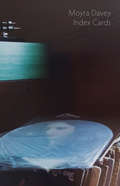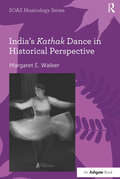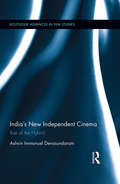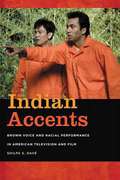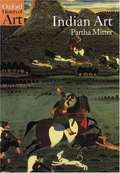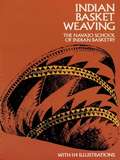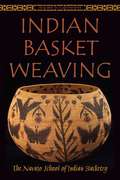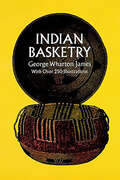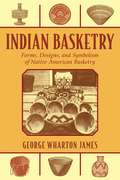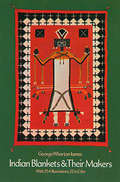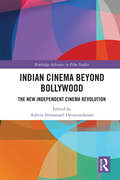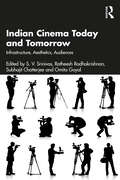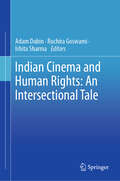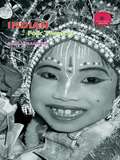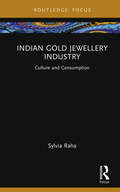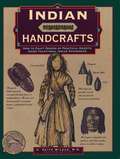- Table View
- List View
Independent Filmmaking and Digital Convergence: Transmedia and Beyond
by Vladan NikolicIndependent Filmmaking and Digital Convergence: Transmedia and Beyond offers a comprehensive analysis of the technological changes of the past few decades in independent film and media-making, and explores new strategies and practices in media production, exhibition and distribution for independent producers and content creators. The book examines how independent filmmaking concepts have merged with digital and online technologies to create new hybrid multi-platform content creations. It explores key questions like how to reach an audience at a time when media conglomerates and their products dominate the market, and simultaneously, there is an overabundance of content competing for viewer time. The book investigates what kind of stories we tell and why; how the audience has changed, and what their expectations are; what the various niche markets are for independent producers and creators in new media; and new models for media financing and distribution. The content found in this book: Bridges the gap between professional media-makers and amateurs by focusing on new and emerging media models and practices. Provides a holistic view of the new media landscape, and practical advice on producing content in the new multi-platform media environment. Demonstrates how to create financially sustainable models for independent producers and creators in a shifting and unstable environment, providing many challenges, but also opportunities for independents. The author's website (http://www.filmconvergence.com/) supports this book with case studies, news and updates.
Independent Filmmaking in South East Asia: Conversations with Filmmakers on Building and Sustaining a Creative Career
by Nico MeissnerFeaturing interviews with 27 award-winning and emerging filmmakers, this book is the first comprehensive look at independent filmmaking careers in South East Asia with never-before published insights into the lives and careers of some of the most influential filmmakers in one of the world’s most exciting screen production regions.Celebrating filmmaking in South East Asia, the interviews offer unique perspectives that highlight the various paths filmmakers have taken to establish and develop their independent filmmaking careers. Presenting filmmakers whose films span narrative, documentary and experimental genres, and from all ten South East Asian nations, the filmmakers in this collection include: Camera d’Or winner Anthony Chen Sundance Grand Jury Prize nominee Mouly Surya NETPAC Award Winner Sheron Dayoc Brunei’s first female director, Siti Kamaluddin Directors of the Wathann Festival, Thaiddhi and Thu Thu Shein Lao’s only female and first horror film director, Mattie Do Aimed at aspiring filmmakers with a focus on career building outside of global production hubs, Meißner has curated a collection of interviews that reflects the diversity and ambition of filmmaking in South East Asia. The book is accompanied by a companion website (www.southeastasianfilmcareers.com) that includes 27 micro-documentaries on the included filmmakers.
Independent Museums and Culture Centres in Colonial and Post-colonial Zimbabwe: Non-State Players, Local Communities, and Self-Representation (Routledge Research on Museums and Heritage in Africa)
by Thomas Panganayi ThondhlanaIndependent Museums and Culture Centres in Colonial and Post-colonial Zimbabwe presents case studies that grapple with the issue of ‘decolonising practice’ in privately owned museums and cultural centres in Zimbabwe. Including contributions from academics and practitioners, this book focusses on privately run cultural institutions and highlights that there has, until now, been scant scholarly information about their existence and practice. Arguing that the recent resurgence of such museums, which are not usually obliged to endorse official narratives of the central government, points to some desire to decolonise and indigenise museums, the contributors explore approaches that have been used to reconfigure such colonially inherited institutions to suit the post-colonial terrain. The volume also explores how privately owned museums can tap into or contribute to current conversations on decoloniality that encourage reflexivity, inclusivity, de-patriarchy, multivocality, community participation, and agency. Exploring the motives and purpose of such institutions, the book argues that they are being utilised to confront deeply entrenched stigmatisation and marginalisation. Independent Museums and Culture Centres in Colonial and Post-colonial Zimbabwe demonstrates that post-colonial African museums have become an arena for negotiating history, legacies, and identities. The book will be of interest to academics and students around the world who are engaged in the study of museums and heritage, African studies, history, and culture. It will also appeal to museum practitioners working across Africa and beyond.
Independent Performing Arts in Europe: Establishment and Survival of an Emerging Field (Routledge Advances in Theatre & Performance Studies)
by Thomas Fabian EderThis structural account of independent performing arts in Europe is complimented by an analysis of the challenging social situation within the field. This book presents a neo-institutional examination of the organizational field including its routines, scripts, and expectations which provides a contribution to theatre studies, labour studies, and to social and cultural policy studies as well as valuable context for current advocacy and governance. This study offers knowledge based on empirical data and thus a foundation that is equally important for scholarly discourse, cross-national learning, and scientifically based recommendations for action to administration, the cultural policy level, and associations alike. The book examines the independent performing arts communities in Austria, Bulgaria, the Czech Republic, Finland, Germany, Hungary, Iceland, Italy, Romania, Slovenia, Sweden and Switzerland.
Independent Press in D.C. and Virginia: An Underground History
by Dale M. BrumfieldThe nation's capital and the state of Virginia were a hotbed of political and social turmoil that marked the 1960s and 1970s. The area saw anti-Vietnam War protests, civil rights marches and students clamoring for a cultural revolution. Underground publications in D.C. and Virginia sprang up to document the radical change and question the "straight media." Off Our Backs led the charge for women's equality. The Gay Blade fought for the rights of homosexuals. Even the FBI began infiltrating the underground press movement by planting informants and creating fake magazines to attract suspicious "radicals." Join author and former underground editor Dale Brumfield as he traces the history of alternative press in the Commonwealth and the District.
Independent Television Production in the UK: From Cottage Industry To Big Business
by David LeeThis book is the first authoritative account of the UK’s independent television production sector, following the creation of Channel 4 in 1982. It examines the rise of a global industry, increasingly interconnected through format development, distribution, ancillary sales and rights. Drawing on case studies, interviews and policy analysis; the author considers the cultural politics behind the growth of the ‘indies’, the labour conditions for workers in this sector, and some of the key television programmes that have been created within it. Filling an important gap in our understanding, this book constitutes a comprehensive account of this vital cultural industry for students, academics and researchers working in the areas of the cultural and creative industries, media and cultural policy and television studies.
Independent for Life: Homes and Neighborhoods for an Aging America
by Henry Cisneros Margaret Dyer-Chamberlain Jane HickieDo you want to age independently in your own home and neighborhood? Staying home, aging in place, is most people's preference, but most American housing and communities are not adapted to the needs of older people. And with the fastest population growth among people over 65, finding solutions for successful aging is important not only for individual families, but for our whole society. In Independent for Life, former HUD Secretary Henry Cisneros and a team of experts on aging, architecture, construction, health, finance, and politics assess the current state of housing and present new possibilities that realistically address the interrelated issues of housing, communities, services, and financial concerns. Independent for Life covers a wide range of smart solutions, including remodeling current housing and building new homes for accessibility and safety, retrofitting existing neighborhoods to connect needed services and amenities, and planning new communities that work well for people of all ages. Case studies show how the proposals can be implemented. The authors offer action plans for working with policy makers at local, state, and national levels to address the larger issues of aging in place, including family financial security, real estate markets, and the limitations of public support. Lists of essential resources, including a detailed "to do" list of aging in place priorities and an individual home assessment, complete the volume.
Indestructible Object
by Mary McCoy&“Beautifully messy and real.&” —Amy Spalding, bestselling author of We Used to Be Friends Perfect for fans of What If It&’s Us and Mary H. K. Choi, this stunning coming-of-age novel from Printz Honor author Mary McCoy follows a Memphis teen whose quest to uncover the secrets of love reveals new truths about herself.For the past two years, Lee has been laser-focused on two things: her job as a sound tech at a local coffee shop and her podcast Artists in Love, which she cohosts with her boyfriend Vincent. Until he breaks up with her on the air right after graduation. When their unexpected split, the loss of her job, and her parent&’s announcement that they&’re separating coincide, Lee&’s plans, her art, and her life are thrown into turmoil. Searching for a new purpose, Lee recruits her old friend Max and new friend Risa to produce a podcast called Objects of Destruction, where they investigate whether love actually exists at all. But the deeper they get into the love stories around them, the more Lee realizes that she&’s the one who&’s been holding love at arm&’s length. And when she starts to fall for Risa, she finds she&’ll have to be more honest with herself and the people in her life to create a new love story of her own. Funny, romantic, and heartfelt, this is a story about secrets, lies, friendship, found family, an expired passport, a hidden VHS tape, fried pickles, the weird and wild city of Memphis, and, most of all, love.
Index Cards: Selected Essays
by Moyra DaveyAn essential selection of Moyra Davey’s sly, surprising, and brilliant essays In these essays, the acclaimed artist, photographer, writer, and filmmaker Moyra Davey often begins with a daily encounter—with a photograph, a memory, or a passage from a book—and links that subject to others, drawing fascinating and unlikely connections, until you can almost feel the texture of her thinking. While thinking and writing, she weaves together disparate writers and artists—Mary Wollstonecraft, Jean Genet, Virginia Woolf, Janet Malcolm, Chantal Akerman, and Roland Barthes, among many others—in a way that is both elliptical and direct, clearheaded and personal, prismatic and self-examining, layering narratives to reveal the thorny but nourishing relationship between art and life.
India's Kathak Dance in Historical Perspective (SOAS Studies in Music)
by Margaret E. WalkerKathak, the classical dance of North India, combines virtuosic footwork and dazzling spins with subtle pantomime and soft gestures. As a global practice and one of India's cultural markers, kathak dance is often presented as heir to an ancient Hindu devotional tradition in which men called Kathakas danced and told stories in temples. The dance's repertoire and movement vocabulary, however, tell a different story of syncretic origins and hybrid history - it is a dance that is both Muslim and Hindu, both devotional and entertaining, and both male and female. Kathak's multiple roots can be found in rural theatre, embodied rhythmic repertoire, and courtesan performance practice, and its history is inextricable from the history of empire, colonialism, and independence in India. Through an analysis both broad and deep of primary and secondary sources, ethnography, iconography and current performance practice, Margaret Walker undertakes a critical approach to the history of kathak dance and presents new data about hereditary performing artists, gendered contexts and practices, and postcolonial cultural reclamation. The account that emerges places kathak and the Kathaks firmly into the living context of North Indian performing arts.
India's New Independent Cinema: Rise of the Hybrid (Routledge Advances in Film Studies)
by Ashvin Immanuel DevasundaramThis is the first-ever book on the rise of the new wave of independent Indian films that is revolutionising Indian cinema. Contemporary scholarship on Indian cinema so far has focused asymmetrically on Bollywood—India’s dominant cultural export. Reversing this trend, this book provides an in-depth examination of the burgeoning independent Indian film sector. It locates the new 'Indies' as a glocal hybrid film form—global in aesthetic and local in content. They critically engage with a diverse socio-political spectrum of ‘state of the nation’ stories; from farmer suicides, disenfranchised urban youth and migrant workers to monks turned anti-corporation animal rights agitators. This book provides comprehensive analyses of definitive Indie new wave films including Peepli Live (2010), Dhobi Ghat (2010), The Lunchbox (2013) and Ship of Theseus (2013). It explores how subversive Indies, such as polemical postmodern rap-musical Gandu (2010) transgress conventional notions of ‘traditional Indian values’, and collide with state censorship regulations. This timely and pioneering analysis shows how the new Indies have emerged from a middle space between India’s globalising present and traditional past. This book draws on in-depth interviews with directors, actors, academics and members of the Indian censor board, and is essential reading for anyone seeking an insight into a current Indian film phenomenon that could chart the future of Indian cinema.
Indian Accents: Brown Voice and Racial Performance in American Television and Film (The Asian American Experience)
by Shilpa S. DaveAmid immigrant narratives of assimilation, Indian Accents focuses on the representations and stereotypes of South Asian characters in American film and television. Exploring key examples in popular culture ranging from Peter Sellers' portrayal of Hrundi Bakshi in the 1968 film The Party to contemporary representations such as Apu from The Simpsons and characters in Harold and Kumar Go to White Castle, Shilpa S. Dave develops the ideas of "accent," "brownface," and "brown voice" as new ways to explore the racialization of South Asians beyond just visual appearance. Dave relates these examples to earlier scholarship on blackface, race, and performance to show how "accents" are a means of representing racial difference, national origin, and belonging, as well as distinctions of class and privilege. While focusing on racial impersonations in mainstream film and television, Indian Accents also amplifies the work of South Asian American actors who push back against brown voice performances, showing how strategic use of accent can expand and challenge such narrow stereotypes.
Indian Art
by Partha MitterThis concise yet lively new survey guides the reader through 5000 years of Indian art and architecture. A rich artistic tradition is fully explored through the Hindu, Buddhist, Islamic, Colonial, and contemporary periods, incorporating discussion of modern Bangladesh and Pakistan, tribalartists, and the decorative arts. Combining a clear overview with much fascinating detail, Mitter succeeds in bringing to life the true diversity of Indian culture. The influence of Islam on the Mughal court, which produced the world-famous Taj Mahal and exquisite miniature paintings is closely examined. More recently, he discussesthe nationalist and global concerns of contemporary art, including the rise of female artists, the stunning architecture of Charles Correa, and the vibrant art scene. The very particular character of Indian art is set within its cultural and religious milieu, raising important issues about the profound differences between Western and Indian ideas of beauty and eroticism in art.
Indian Art And Culture: For Civil Services And Other Competitive Examinations
by Nitin SinghaniaMcGraw-Hill is proud to present third edition of their bestseller “Indian art and Culture” by Nitin Singhania, third edition. This book offers comprehensive and latest information covering the broad field of knowledge on Indian art, paintings, music and architecture for the aspirants of Civil Services Preliminary and Main Examinations. Apart from two new chapters and one appendix, the chapters have been enriched with details to make it more focused and comprehensive. There are questions at the end of each chapter which will help students prepare for the examinations. Highlights: All new four colour edition, Comprehensive 4 sections: Visual arts, Performing arts, Culture of India and Appendices, New chapters on Buddhism and Jainism + India through the eyes of foreign travelers, New appendix on Current affairs related to Indian Art and Culture, Videos related to the chapters available through QR codes, Keywords in every chapter highlighted in color, Updated Previous Year Questions and Answers of UPSC Preliminary and Main Examination.
Indian Basket Weaving
by Navajo School of Indian BasketryThe methods of Indian basket weaving explained in this excellent manual are the very ones employed by native practitioners of the craft. members of the Navajo School of Basketry have set down their secrets in clear and simple language, enabling even the beginner to create work that can rival theirs in grace, design, and usefulness.Beginning with basic techniques, choice of materials, preparation of the reed, splicing, the introduction of color, principles and methods of design, shaping the basket and weaves from many cultures, such as Lazy Squaw, Mariposa, Taos, Samoan, Klikitat, and Shilo, each accompanied by specific instructions. There are suggestions for the weaving of shells, beads, feathers, fan palms, date palms, and even pine needles, and recipes for the preparation of dyes.Examples of each type of basket are illustrated by photographs, often taken from more than one angle so that the bottom can be seen as well as the top and sides. Close-up photography of the various types of stitching, especially at the crucial stage of beginning the basket, is an invaluable aid to the weaver. In addition, the authors have provided line drawings which are exceptionally clear magnifications of the various weave patterns.Anyone who follows the lessons contained in this book will have a knowledge of basketry unattainable in any other way. They are so lucid and complete that the amateur as well as the experienced weaver will be able to manufacture baskets distinguishable from authentic native articles only in that they were not woven by Indians. For those who merely seek a broader knowledge of American Indian arts, the book provides a comprehensive introduction to the subject of basketry.
Indian Basket Weaving: The Navajo School Of Indian Basketry
by The Navajo School of Indian BasketryThe methods of Indian basket weaving explained in this excellent manual are the very ones employed by native practitioners of the craft. Members of the Navajo School of Indian Basketry have set down their secrets in clear and simple language, enabling even the beginner to create work that can rival theirs in grace, design, and usefulness.The text begins with basic techniques: choice of materials, preparation of the reed, splicing, the introduction of color, principles and methods of design, shaping the basket and finishing. A great variety of baskets and weaves from many cultures are described in subsequent chapters, such as Lazy Squaw, Mariposa, Toas, Samoan, Klikitat, and Shilo, each accompanied by specific instructions. There are suggestions for the weaving of shells, beads, feathers, fan palms, date palms, and even pine needles, and recipes for the preparation of dyes.Examples of each type of basket are illustrated by photographs, often taken from more than one angle so that the bottom can be seen as well as the top and sides. Close-up photography of the various types of stitching, especially at the crucial stage of beginning the basket, is an invaluable aid to the weaver. In addition, the authors have provided line drawings which are exceptionally clear magnifications of the various weave patterns.Anyone who follows the lessons contained in this book will have a knowledge of basketry unattainable in any other way. They are so lucid and complete that the amateur as well as the experienced weaver will be able to manufacture baskets distinguishable from authentic native articles only in that they were not woven by Indians. For those who merely seek a broader knowledge of American Indian arts, the book provides a comprehensive introduction to the subject of basketry.
Indian Basketry
by George W. JamesSince it first publication in 1901, this pioneering study by George Wharton James, once a leading collector and authority, has become a valuable source book for American Indian basketry. From Poma mush baskets to Paiute dicing trays, Indian Basketry traces the origin, development, and fundamental principles of Indian basket designs for the major tribal units in Southwestern United States and Pacific Coast, with occasional comments on the basket weaving of a number of other North American tribes.Author of several books on the Southwest, George James has used his extensive experience in the field to compile indispensable information (much gathered directly through interviews with Indian basketmakers) covering nearly every aspect of Indian basketry: esthetics, designs, dyes, and coloration, weaving and stitching techniques (including the bamtush and dah-lah methods), basket types, tribal variation, and functional considerations, offering clear instructions for those who may be interested in reproducing these ancient American crafts. James also includes a description of various native weaving materials such as pine root, bark, sumac, willow, twigs, fern stalks, grass and palm fronds, with suggestions regarding the ways in which the Indians wove shells, feathers, beads, leather, and pine needles into their basket designs.The book is a valuable aid for the artist, designer, and craftsman, or even for the beginner, who may wish to re-create authentic and often extinct basket forms and decorative motifs. It is also most useful to the collector, cultural historians, ethnologist, scholar, or buff, who desires to know more about specific aspects of Indian basketry, or about Indian arts in general. As an important contribution to the historiography of American Indian culture, this may be one of the most practical Indian basketry books that you could own.
Indian Basketry: Forms, Designs, and Symbolism of Native American Basketry
by George Wharton JamesEverything there is to know about traditional Native American basket weaving.Native American basket weaving is an intricate and powerful art, representative of the legends and ceremonies of the Indian nations and their cultures. George Wharton James's Indian Basketry is an invaluable aid for the artist, designer, craftsman, or beginner who wants to recreate authentic and often extinct basket forms and decorative motifs of the Native American peoples.Filled with 355 illustrations and photographs of Native American basket weavers taken at the turn of the twentieth century, this pioneering study-first published in 1901-provides in-depth information about specific aspects of Indian basketry, including: Its role in legend and ceremony The origins of forms and designs Materials and colors used Weaves and stitches The symbolism and poetry woven into each basket Preservation Tips for the collector And much more!From Yolo ceremonial baskets to Oraibi sacred trays, Indian Basketry traces the origin, development, and fundamental principles of the basket designs of the major Indian tribes of the southwestern United States and Pacific Coast, along with comments on the basket weaving of a number of other North American tribes.
Indian Blankets and Their Makers
by George Wharton JamesHistory, old-style wool blankets, changes brought about by traders, symbolism of design and color, a Navajo weaver at work, more. Emphasis on Navajo. Includes information on the Bayeta blanket, squaw dresses, dyeing, belts, garters, hair braids, imitation blankets, the Chimayó blanket, and reliable dealers. 254 illustrations, 32 in color.
Indian Cinema Beyond Bollywood: The New Independent Cinema Revolution (Routledge Advances in Film Studies)
by Ashvin Immanuel DevasundaramThis is the first edited volume on new independent Indian cinema. It aims to be a comprehensive compendium of diverse theoretical, philosophical, epistemological and practice-based perspectives, featuring contributions from multidisciplinary scholars and practitioners across the world. This edited collection features analyses of cutting-edge new independent films and is conceived to serve as a beacon to guide future explorations into the burgeoning field of new Indian Cinema studies.
Indian Cinema Today and Tomorrow: Infrastructure, Aesthetics, Audiences
by S. V. Srinivas, Ratheesh Radhakrishnan, Subhajit Chatterjee, and Omita GoyalCinema has been, and is, a powerful tool for social mobilisation. The political importance of cinema was of course always well-known and has continued to evolve and grow. However, with innovations in modern technology, there has been the exponential growth of television alongside the movies, with content made especially for TV, as well as social media.This volume covers developments in Indian Cinema over the last decade. It explores an array of changes which has dramatically changed cinema — a surge of new filming and broadcasting technologies, from the camera phone to the most sophisticated digital equipment; an avalanche of talent, from trained to completely untrained actors; and a volume of content difficult to document and categorise. It also studies cinema growth and reactions to the onslaught of home entertainment and discusses its changing formats over the years, from TV to satellite, to VCRs and DVDs, serials to OTT streaming platforms.This book will be of great interest to scholars and researchers in film studies, performance studies, cultural studies, media studies, and popular culture. It will also interest professionals working in media and entertainment industries.
Indian Cinema and Human Rights: An Intersectional Tale
by Adam Dubin Ruchira Goswami Ishita SharmaThis book examines the intersection between Indian cinema (across geographic regions, languages and formats) and human rights. It analyzes Indian cinema from multiple human rights perspectives, such as freedom of expression and censorship, socio-economic rights, caste rights, women's and children's rights and LGBTQIA+ equality. The book bridges human rights law and cinema studies, and opens up new research areas within sociocultural and socio-legal academic contexts. It also contributes to academic disicplines beyond Law and Cinema, including Media, Cultural, Gender, Socio-economic and Sociology studies and is relevant for Liberal Arts curricula, Law Schools and as a reference book in university libraries in India and internationally, especially in film institutes. Finally, the book offers practical implications for human rights activists and policymakers by exploring how rights can be advanced through cinema and pop culture.
Indian Folk Theatres
by Julia HollanderIndian Folk Theatres is theatre anthropology as a lived experience, containing detailed accounts of recent folk theatre shows as well as historical and cultural context. It looks at folk theatre forms from three corners of the Indian subcontinent: Tamasha, song and dance entertainments from Maharastra Chhau, the lyrical dance theatre of Bihar Theru Koothu, satirical, ritualised epics from Tamil Nadu. The contrasting styles and contents are depicted with a strongly practical bias, harnessing expertise from practitioners, anthropologists and theatre scholars in India. Indian Folk Theatres makes these exceptionally versatile and up-beat theatre forms accessible to students and practitioners everywhere.
Indian Gold Jewellery Industry: Culture and Consumption (Routledge Focus on Management and Society)
by Sylvia RahaIndia has a long-standing cultural and societal affinity with gold and gold jewellery. Gold metaphorically represents the sacredness, purity and immortality that bind religious beliefs and culture together. Accumulation of gold is associated with material and non-material cultures where the perceptions, attitudes and experiences of the members engaged in production and consumption are bound into a complex relationship. The idea of the book initially originated from the course of research work. It was found that India has the largest unorganised jewellery industry, in terms of manufacturing and consumption unit. Jewellery fabrication in India is not just a profession for the jewellers, but it has been a family tradition extending across generations. Gold jewellery makers (sunnar, swarnakars) are the spine of the jewellery industry. They acquired the skill of making jewellery from the experienced and learned gold smithery (karigars), either from their ancestors who were engaged in this business or from the craftsmen-cum-petty traders. The co-relations of castes, religion, culture, economy and class are intertwined with each other in such a way that made the gold jewellery industry sustainable. Surprisingly, there is an absence of literature on understanding the structural and functional aspects of the gold jewellery industry in India.This book explores the roles of sunars/swarnakars (goldsmith or jewellery makers), consumers, trade and the policies that bring a change in the gold jewellery industry in India and India’s position in the global market scenario. By focusing on their way of life, the book brings unique insights into the social and economic experience of the unorganised gold jewellery sector and the role of consumers in production.
Indian Handcrafts: How To Craft Dozens Of Practical Objects Using Traditional Indian Techniques (Illustrated Living History Series)
by C. Keith WilburIndian Handcrafts explains how each object evolved, how it was used, and what tools and materials you need to re-create it.
